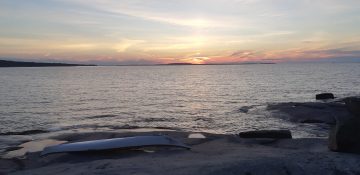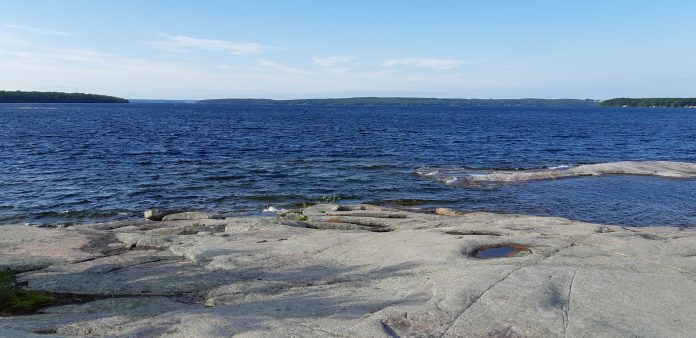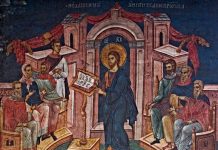I’ve been gone for a couple of days, on pilgrimage to Martyrs’ Shrine, in Midland, Ontario, of which I have written a number of times before, commemorating the eight Jesuits who were put to death in odium fidei by the Iroquois back in the mid-seventeenth century. The site of Saint-Ignace, where Saints Jean de Brebeuf and Gabriel Lalement met their end by tortures that evoke those of Nero’s incipient demonic fury unleashed on the first Christians, is perhaps the holiest place in Canada, a nondescript field, with three simple wooden crosses, and a covered stone altar.
The shrine itself has a large, stone church, set on top of a hill, with a large acreage of grounds, dotted with statuary and altars dedicated to ethnic devotions, from the Chinese to the Lithuanian and Italian and Filipino. I did not see many pilgrims – a few, dotted here and there, not like the throngs at Lourdes – and I wonder. As I mentioned just this morning to the shrine’s Director, Father Michael Knox, Canada is much like the Japan described by Shusako Endo in his controversial novel Silence, a vast, miasmic swamp, which swallows up religious or transcendent impulse. Socialism doesn’t help, creating an ‘economy’ wherein one need not work, and, in fact, much work is disincentivized. Neither does a Tim Horton’s and McDonald’s dietary culture. Nor do video games and addiction to streaming, social media, porn….
But I digress: Stay positive, for the beauty of the shrine is in its very simplicity, its scenic rusticity, which still looks much as though the early missionaries might have found it, if with fewer trees.
Late in the evening, I kayaked out to an island, which the sturdy Jesuits may have visited as they approached by heavily-laden canoes what would become their home base of Sainte Marie. The island I chose is about a mile south of another island named in honour of Brebeuf, now a summer make-work project for university students as a ‘coast guard’ outpost. The beauty of the ancient, weathered rocks, sloping into the clear, fresh water of Georgian Bay; rarely have I swum in a place so naturally adapted to plunging right in. The water just beckons one, and the rocks provide a natural platform from which to build one’s courage to take the leap.
And the glory of the sunsets, well, can scarcely be described.

Samuel de Champlain – the first European ‘white man’ to see the vast body of water – called it La Mer Douce, the ‘calm sea’, which is somewhat ironic for those who have experienced her fury, but it was re-named by the British, as were so many things, in 1822, after their fourth monarch named George – who has gone down in history – and one must take such history with some grain of salt – as a national joke, an ungoverned libertine who treated people abominably, not least his own long-suffering wife, Caroline, whom he tried to divorce when such was thankfully still mostly illegal, drowning the nation in debt and his own life in a sex-and-drug addled dissolution. Now that I write that, George may be a fitting symbol of what Canada has become. Sure enough, George was raised – if such be the word – by a father who descended into insanity, but we choose what we make of our lives, with what cards we are dealt.
Alas, Georgian Bay, like so many other places, has become a rich man’s paradise – I suppose the custom is now ‘rich person’, even if most still be of the male sex. Just on the CBC this morning, I was amused to hear that the term ‘man-hole’ is verboten. Person hole? All down the Alice-in-wonderland rabbit hole into which we are descending.
But back to the ‘thousand islands’, many of them have been bought up by millionaires who, from the apparent desertion of their mansion-cottages, seem to spend only a fraction of their time there. I am actually surprised to see living beings outside some of them, as I ply my way through their watery backyards not visible from street-side.
Yes, it may be difficult for the hoi polloi to access the natural splendour, but there are still ways, for those who try. For one, paddling around on my kayak, the whole world is my waterfront. But there are beaches, public, and those more hidden, hikes, trails, and vistas.
Whatever be your proclivity, I would recommend a pilgrimage to the Shrine and to the area; spend a few days; visit the sites; pray for Canada, for our Church, which need them mightily; for your loved ones, for the blood of the martyrs crying out to heaven was and is not shed in vain. Even if we suffer not as they did, or in the same way, we may participate in their merits and prayers, and so become the people we were – are – meant to be.










